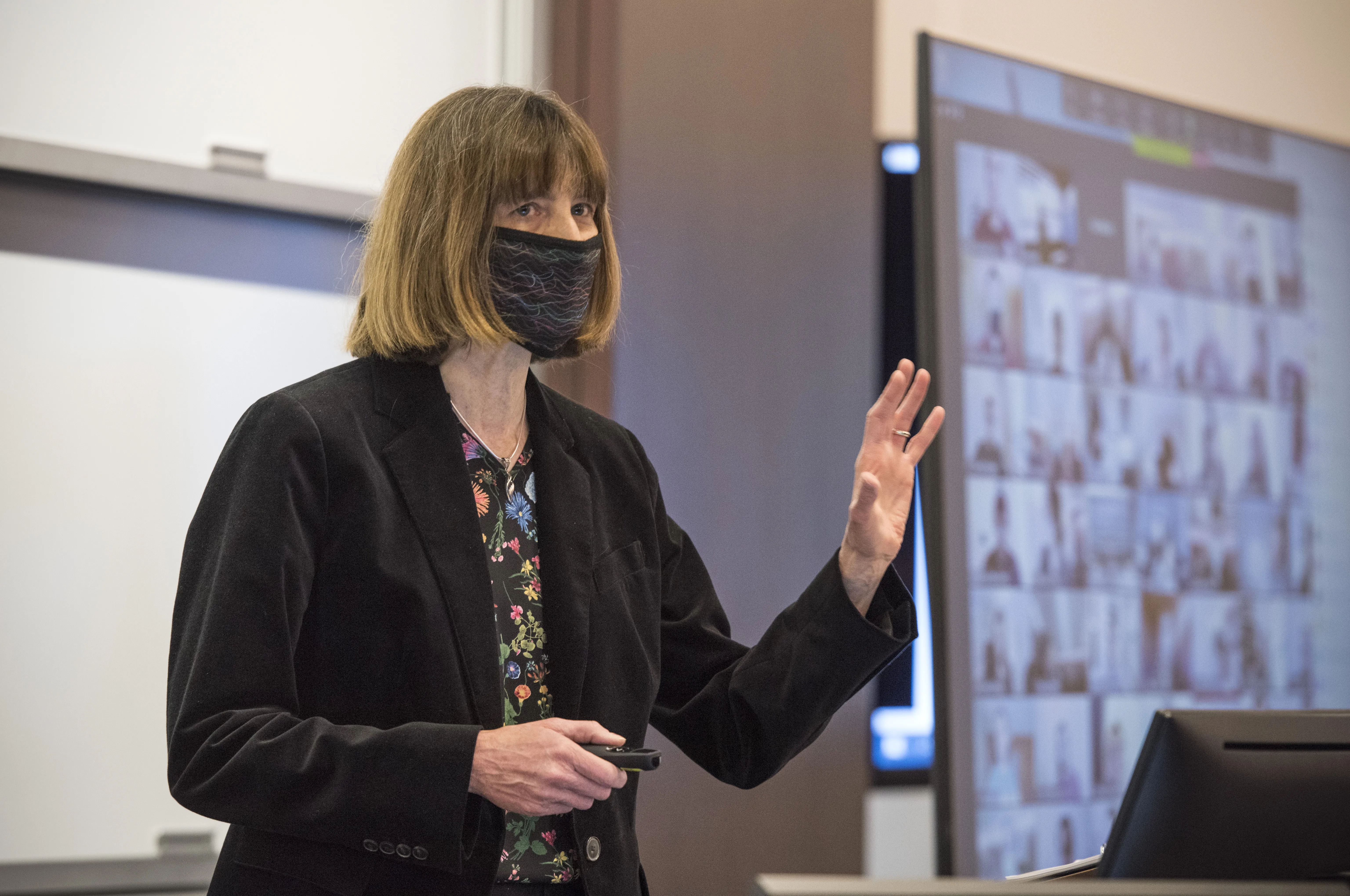The Lessons of the Midway

Thanks everyone for joining me here this evening. It’s a great honor to get to do the Midway speech. The Midway celebration is our most distinctive and iconic tradition. Everything about it reminds me of what I love about Chicago. As you all know, “midway” means many things, and as best I can tell, it’s the job of the Midway speaker to talk about as many of them as possible. I will do my best.
First, “midway” refers to your progress through Law School. Here we are at Halfway Road! That we make a point to not just notice but actively celebrate that fact sets us apart. Beginnings and endings are always commemorated but middles are usually ignored.
Not entirely. The Iditarod sled dog race, which follows a route of about 1,000 miles from Anchorage to Nome, honors the first musher to reach the midpoint, the checkpoint of Iditarod, with an award and $3,000 in gold nuggets. (This year, the race is following a modified loop route for COVID-19 reasons, and will actually turn around at Iditarod rather than proceeding to Nome, making the halfway point all the more notable). Now, admittedly, this is the only other example I could readily come up with of middle-celebration. Which is a little weird, because I can’t think of any obvious connections between long-distance trekking across difficult, uneven terrain while facing sleep deprivation, blizzards, and subzero temperatures, and the experience of attending our Law School.
There are other meanings of “midway.” Our signature Chicago interdisciplinarity involves taking some of this and some of that to make something new that is neither and yet somehow both at the same time. Because the Midway Plaisance cross-cuts our campus, the metaphor of “crossing the Midway” works as a shorthand for this vast feast of intellectual possibilities that lies open to you. Here is it used in a sentence: Should I take classes across the Midway? Answer: Yes! The Law School website even helpfully lists a wide array of courses that law students have taken in the past to pique your interest So you are going to want to check that out.
This evening, though, I want to highlight another meaning of midway: the fun parts of a fair or exhibition, a place of amusements, of games of skill and chance! What lessons can we take from that meaning? Midway has become a generic word, but it has a specific history: our Midway Plaisance was part of the grounds for the 1893 Columbian Exposition, and it contained some of the coolest attractions, including the original Ferris Wheel. You can see in these images [click “Highlights” and look for Bird’s Eye View, Map of the Grounds, and Midway Plaisance] where it was relative to where the Law School is now. Basically in our front yard. In addition to the massive Ferris Wheel, which had cars that could hold up to 60 people each, there was also an ice railway, a tethered hot air balloon, and an ostrich exhibit, to name but a few of the eclectic offerings.
For all its varied spectacle, the Midway (and the Columbian Exposition more generally) suffered from serious failings. Its operations and exhibits were marred by racial discrimination and exclusion, which Frederick Douglass and Ida B. Wells spoke out against. So the first lesson of the Midway that I want to emphasize tonight is the imperative of working toward more inclusive institutions and practices and against the discrimination that impoverishes us all. Our society and the laws that govern it are, as you are learning, always under construction, always unfinished, perpetually in the midst of being built, and you have the opportunity and obligation to be a transformative part of that process—even when you are still in the middle of law school.
What I want to do with my remaining time is not to celebrate the historic Midway as it actually existed, but instead focus on what we can take away from the idea of the Midway, from the best version of what a Midway might set out to do: to amaze, to amuse, and to offer a place for people to come together and learn from each other.
The next lesson of the Midway is the importance of both big dreams and careful revision. Not all of the ideas for grand Midway spectacles made it to the actual Midway. Here are two examples of ideas that were proposed but not enacted: one for an underground mine that people could descend six hundred feet into the Earth to explore, and another for a dirigible called “The Carmel Airship.” [Norman Bolotin & Christine Laing, Chicago’s Grand Midway: A Walk Around the World at the Columbian Exposition 15 (2017)]. The Midway Dinner fundamentally celebrates the work in progress, the rough draft, the unfinished, the half-built, the dreamed but not yet realized. This is where creativity happens, and it’s what Chicago is all about. Instead of having a faculty lounge like every other law school, we have a faculty workshop. We are big on generating ideas, but we are also also big on scrapping them if they don’t work. We poke holes in each other’s scholarship, and in yours, to push the author to build it back better, or if it can’t be salvaged, move on to something more promising. You see a similar process of testing and pushing at work in the classroom. We spend most of our time in the space between ideation and realization, where we have to figure out what works and what doesn’t. That we come up with bold plans that don’t always fly—as long as we figure it out before they’re in the air—is something to celebrate.
Another Midway theme is to capture the moment as it’s happening, while you can. There was a very literal representation of this idea in another exhibit on the Midway during the Columbian Exposition: The Zoopraxographical Hall, where Eadweard Muybridge displayed his work on animal motion. These frame-by-frame images of horses enabled him to answer a burning question of the day: does the galloping horse ever go completely airborne? Answer: Yes. We should not neglect to look closely at the unfolding action as it happens, the Midway reminds us. William Faulkner had something similar in mind when he spoke of the writer’s goal of capturing “the furious motion of being alive.” [William Faulkner, Faulkner in the University 239 (1959)] As he put it, “You catch this fluidity which is human life and you focus a light on it and you stop it long enough for people to be able to see it.” [Id.] We just have to remember to look.
The next lesson of the Midway is to try your luck at games of skill and chance! Modern-day fair midways are filled with such games, most of which are nearly impossible to win. This should not stop you from trying! When I was growing up and attending the Oklahoma State Fair I would always try some version of this rope ladder. I was convinced I could win the giant stuffed animal! Of course I never did. I’d get tantalizingly close and then the rope would twist. It turns out there’s a trick to this, and it has something to do with balancing yourself midway between the ropes, which you can only accomplish by avoiding your instinctive reaction to grab the rungs when you climb.
Sadly, there is no way for me to replicate this rope ladder here this evening for people to try, but there’s another standard carnival game that translates a little bit better to the Zoom format: “Cover the Spot!” The object is to take the small circles and try to completely cover up the red circle. It’s harder than it looks. Now you could download this game and waste a lot of time playing it on your own. But because it’s way more fun to do something tricky in front of a large audience (see, e.g., the Socratic method) I’m going to see if I can get a student volunteer to try this game. All you do is move these silver discs in a standard drag-and-drop operation and once you place each one, you cannot move it again. Once you’re done, it tells you how many pixels you missed.
I’m going to give you a hint about how to win this game, and the hint is “midway.” Midway is the answer to the question that goes: where on a circle will you find the widest point? Okay, this game is hard even if you have some idea how to do it. You may feel the same way trying out a new discipline with a new vocabulary and different ways of saying and doing and knowing. But dive in there anyway. The process of trying to solve even an essentially meaningless problem like this one can help you look at things from a new perspective. Which brings me to my last lesson of the Midway ...
Enjoy the view! Trying something new may mean going outside your comfort zone, but it can also give you a fresh look at the world. Here is a quote from Norman Bolotin and Christine Laing’s book, Chicago’s Grand Midway 42 (2017): “Sitting or standing in a car hanging on an 825-foot circumference wheel was so far beyond everyone’s experiences that most simply gazed quietly; the rare exception was the passenger overcome with vertigo or fear who punctuated the incredibly quiet ride with a momentary scream.” So be amazed, scream if you need to, but make sure you don’t miss the ride. Here is a painting of the view from the Ferris Wheel. The caption does not specify the exact position on the wheel represented by this view, but if I had to guess, I’d say it was at the midway point, at the top of the wheel, where the view is the best. You won’t have it forever, so take it in while you can.
To the Midway!
